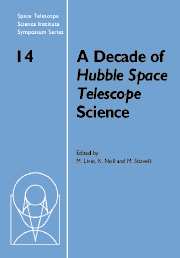Book contents
- Frontmatter
- Contents
- Participants
- Preface
- HST studies of Mars
- HST images of Jupiter's UV aurora
- Star formation
- SN1987A: The birth of a supernova remnant
- Globular clusters: The view from HST
- Ultraviolet absorption line studies of the Galactic interstellar medium with the Goddard High Resolution Spectrograph
- HST's view of the center of the Milky Way galaxy
- Stellar populations in dwarf galaxies: A review of the contribution of HST to our understanding of the nearby universe
- The formation of star clusters
- Starburst galaxies observed with the Hubble Space Telescope
- Supermassive black holes
- The HST Key Project to measure the Hubble Constant
- H0 from Type Ia supernovae
- Strong gravitational lensing: Cosmology from angles and redshifts
SN1987A: The birth of a supernova remnant
Published online by Cambridge University Press: 13 August 2009
- Frontmatter
- Contents
- Participants
- Preface
- HST studies of Mars
- HST images of Jupiter's UV aurora
- Star formation
- SN1987A: The birth of a supernova remnant
- Globular clusters: The view from HST
- Ultraviolet absorption line studies of the Galactic interstellar medium with the Goddard High Resolution Spectrograph
- HST's view of the center of the Milky Way galaxy
- Stellar populations in dwarf galaxies: A review of the contribution of HST to our understanding of the nearby universe
- The formation of star clusters
- Starburst galaxies observed with the Hubble Space Telescope
- Supermassive black holes
- The HST Key Project to measure the Hubble Constant
- H0 from Type Ia supernovae
- Strong gravitational lensing: Cosmology from angles and redshifts
Summary
Supernova 1987A has been a prime target for the Hubble Space Telescope since its launch, and it will remain so throughout the lifetime of HST. Here I review the observations of SN1987A, paying particular attention to the rapidly developing impact of the blast wave with the circumstellar matter as observed by HST and the Chandra Observatory.
Introduction
If there was ever a match made in heaven, it is the combination of SN1987A and the Hubble Space Telescope. Although the HST was not available to witness the first three years after outburst, it has been the primary instrument to observe SN1987A since then.
SN1987A in the Large Magellanic Cloud is the brightest supernova to be observed since SN1604 (Kepler), the first to be observed in every band of the electromagnetic spectrum, and the first to be detected through its initial burst of neutrinos. Although the bolometric luminosity of SN1987A today is ≈ 10-6 of its value at maximum light (Lmax ≈ 2.5 × 108 L⊙), it will remain bright enough to be observed for many decades in the radio, infrared, optical, UV, and X-ray bands.
SN1987A is classified as a Type II supernova (SNeII) by virtue of the strong hydrogen lines in its spectrum. It was atypical of SNeII in that its light curve did not reach maximum until three months after outburst and its maximum luminosity was about 1/10 the mean maximum luminosity of SNeII.
- Type
- Chapter
- Information
- A Decade of Hubble Space Telescope Science , pp. 64 - 77Publisher: Cambridge University PressPrint publication year: 2003



